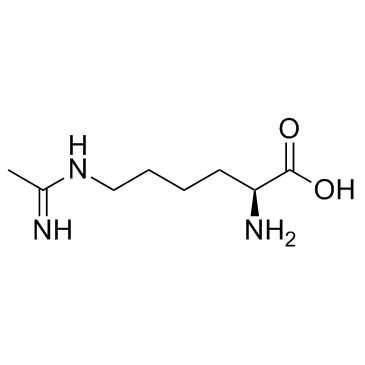53774-63-3
| Name | n-(5-amino-5-carboxypentyl)-acetamidine |
|---|---|
| Synonyms |
N-(5-Amino-5-carboxypentyl
L-Lysine,N6-(1-iMinoethyl) H-LYS(ACETIMIDOYL)-OH LYSINE(ACETIMIDOYL)-OH H-LYS(1-IMINOETHYL)-OH N-(5-AMino-5-carboxypentyl)-acetaMidine,H-Lys(1-iMinoethyl)-OH,L-NIL Ne-Acetimidoyl-L-lysine L-NIL |
| Description | L-NIL is a potent and selective inhibitor of inducible NO synthase with IC50s of 3.3 and 92 μM for mouse inducible NO synthase and rat brain constitutive NO synthase, respectively. |
|---|---|
| Related Catalog | |
| Target |
IC50: 3.3 μM (mouse inducible NO synthase), 92 μM (rat brain constitutive NO synthase)[1] |
| In Vitro | L-NIL produces a concentration-dependent inhibition of both the mouse inducible NOS (miNOS) and the rat brain constitutive NOS (rcNOS) and is considerably more potent for miNOS. The IC50 values for L-NIL with miNOS and rcNOS are 3.3 and 92 pM, respectively, indicating that L-NIL is 28-fold more selective for miNOS. In addition, L-NIL has approximately 6-fold greater potency for miNOS than either L-NMA or L-NNA[1]. |
| In Vivo | L-NIL may prove particularly useful in determining the role of nitric oxide production by inducible NOS in models of chronic inflammation (e.g., adjuvant arthritis)[1]. L-NIL suppresses the increase in plasma nitrite levels and joint inflammation associated with adjuvant-induced arthritis in a dose-dependent manner. L-NIL attenuates the inducible nitric oxide synthase immunoreactivity in adjuvant-treated rats. L-NIL protects the integrity of the tarsal, talus and calcaneus bones as well as the soft tissue surrounding the joint, while adjuvant controls exhibit severe deterioration of these bones and dramatic soft tissue swelling[2]. L-NIL limits progression of preexisting atherosclerosis in hypercholesterolemic rabbits. Increased intimal collagen accumulation may participate in iNOS-induced atherosclerosis progression[3]. |
| Animal Admin | Rats: Nitric oxide synthase inhibitors are administered either by i.v. infusion or in the drinking water. For i.v. infusion of the inhibitors, aminoguanidine (3 M in buffered saline) or L-NIL (1 M in buffered saline) is administered using an osmotic minipump cannulated to the jugular vein beginning the same day as adjuvant administration. When added to the drinking water, aminoguandine is given at a dose of I mg/mL and L-NIL is given at a dose range of 1-100 μg /mL beginning 3 days prior to adjuvant administration. At the end of the experiment, the left femoral artery is cannulated and systemic blood pressure is measured in conscious, restrained animals[2]. |
| References |
| Molecular Formula | C8H17N3O2 |
|---|---|
| Molecular Weight | 187.23900 |
| Exact Mass | 187.13200 |
| PSA | 99.20000 |
| LogP | 1.34630 |
| Storage condition | 2-8℃ |
